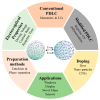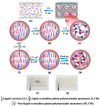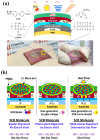Recent Advances in The Polymer Dispersed Liquid Crystal Composite and Its Applications
- PMID: 33255525
- PMCID: PMC7727789
- DOI: 10.3390/molecules25235510
Recent Advances in The Polymer Dispersed Liquid Crystal Composite and Its Applications
Abstract
Polymer dispersed liquid crystals (PDLCs) have kindled a spark of interest because of their unique characteristic of electrically controlled switching. However, some issues including high operating voltage, low contrast ratio and poor mechanical properties are hindering their practical applications. To overcome these drawbacks, some measures were taken such as molecular structure optimization of the monomers and liquid crystals, modification of PDLC and doping of nanoparticles and dyes. This review aims at detailing the recent advances in the process, preparations and applications of PDLCs over the past six years.
Keywords: applications; doping; polymer-dispersed liquid crystals; polymerization induced phase separation.
Conflict of interest statement
The authors declare no conflict of interest.
Figures








References
-
- Zhong T., Mandle R.J., Goodby J.W., Zhang L., Zhang C. Comparative studies of polymer-dispersed liquid crystal films via a thiol-ene click reaction. Polym. Adv. Technol. 2019;30:2781–2789. doi: 10.1002/pat.4710. - DOI
-
- Shen W., Wang L., Zhong T., Chen G., Li C., Chen M., Zhang C., Zhang L., Li K., Yang Z., et al. Electrically switchable light transmittance of epoxy-mercaptan polymer/nematic liquid crystal composites with controllable microstructures. Polymer. 2019;160:53–64. doi: 10.1016/j.polymer.2018.11.022. - DOI
-
- Hu G., Chen H., Liu Z., Zhang S., Zhou Y., Zhu B., Gu H. Tailoring structure and properties of polymer-dispersed liquid crystal by quenching process. Liq. Cryst. 2020;46:1–9. doi: 10.1080/02678292.2020.1750070. - DOI
-
- Li C., Chen M., Shen W., Chen G., Zhang L., Yang H. A study on the polymer structures and electro-optical properties of epoxy-mercaptan-based polymer dispersed liquid crystal films. Liq. Cryst. 2019;46:1718–1726. doi: 10.1080/02678292.2019.1595759. - DOI
-
- Ghosh A., Sundaram S., Mallick T.K., Mallick T.K. Evaluation of thermal performance for a smart switchable adaptive polymer dispersed liquid crystal (PDLC) glazing. Sol. Energy. 2020;195:185–193. doi: 10.1016/j.solener.2019.11.024. - DOI
Publication types
MeSH terms
Substances
Grants and funding
LinkOut - more resources
Full Text Sources
Other Literature Sources
Miscellaneous

